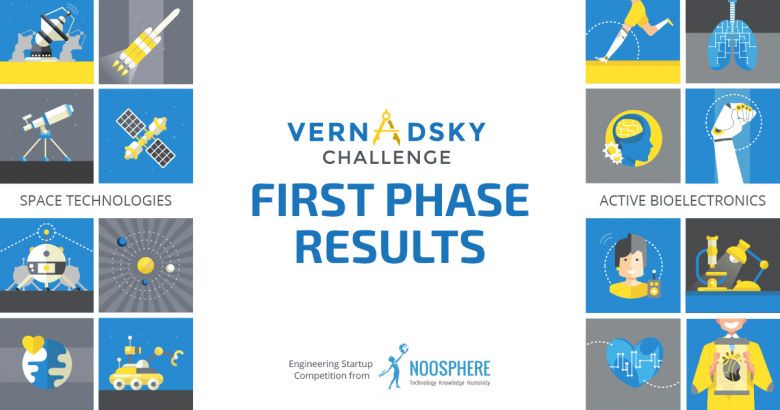On September 10, the first stage of the Vernadsky Challenge engineering startup competition was completed. This year, the international competition became even more global. The number of applications almost doubled compared to 2019. The organizers received 132 applications from 36 countries. The focus of interest is still on projects in the space technology and active bioelectronics fields. “Active bioelectronics” and “space technology” received 74 and 58 participant applications respectively.
Successes and challenges facing Ukrainian startups
Of all the countries with representatives in the Vernadsky Challenge, Ukraine is the leader in representation. This year, Ukrainian projects accounted for 43 applications. This just goes to show that interest in Ukrainian space technology and active bioelectronics startups is not waning. In fact, these are more than ideas on paper — over half of the projects are in prototype development and have completed lab testing. Space technology applications from Ukraine had a turnout of 25 applications. Most of these were focussed on equipment for spacecraft (cameras, sensors, communication devices). It is also worth acknowledging the 7 applications from space launch startups. Two of them made it to the finals – the interorbital vehicle energy module project and a liquid-fueled rocket engine. Satellites were not far behind as far as number of applications. 4 applications were in this area, and the new small satellite format PancakeSat team reached the finals.
In “active bioelectronics,” Ukrainian startups were responsible for 18 applications. Those familiar with the category have seen the greatest promise with wearable medical devices. One to pay attention to in the “active bioelectronics” group is the startup Provizio, which is developing the world’s first home glaucoma monitoring system. The smart device will measure intraocular pressure and alert the doctor in real time about any changes, which can help delay vision loss.
Ukrainian participants pay great attention to technical aspects, but also need a clearly defined business strategy. The issues of procuring funds for startup development, entering the market and finding their audience remain relevant for them. This also applies to projects developed with backing from scientific complexes and universities. The main challenge for participants at this stage is to evolve from perpetual startup to a full-fledged market player. The Vernadsky Challenge can be a useful experience for participants from Ukraine in overcoming this challenge.
How did foreign startups represent themselves?
The best foreign teams proved themselves in the category of “active bioelectronics” where organizers received 56 applications. The main part of the applications came from wearable medical device projects. The Medicsen startup attracted attention with their smart device for non-invasive drug administration. The concept can be useful for patients with diabetes. No less interesting is Iscaffpharma’s use of 3D printing to fight cancer. The startup team has developed technology to print samples of malignant tumors, which will allow for more accurate cancer research while limiting the unethical use of animal testing. Prosthesis development and exoskeletons did not lose their popularity. In 2019, first place went to Esper Bionics’ biomechanical prosthesis with the possibility of machine learning. This year, foreign contestants sent seven applications in this area. Participants are also trying their hand at neurostimulation to treat neurological diseases and pain syndromes.
The field of space technology lost popularity among foreign startups. The Vernadsky Challenge organizers received 33 foreign applications in this area. Although the coronavirus has caused some adjustments, there is a growing need in the world to launch spacecraft to bring payloads into orbit. This was a common theme among the startups. Participants sent their concepts for new types of rockets, engines and other equipment. An innovative example of a project in launches is the Slovak company BOROSPACE, which is redesigning lithium-ion batteries. It will allow the use of batteries not only for energy storage, but also as a hybrid rocket fuel after depletion.
As for the geography of foreign space projects, the United States has the highest showing with five applicant projects. Next are Poland, India and Canada, with 3 applications each. The finalists included the Canadian company FLITE Material Sciences, which is working on laser surface functionalization of metals, glass and composites for aviation and space. The design will change the surface color, as well as its ability to absorb or repel water and oil.
The first stage of the Vernadsky Challenge 2020 competition showed that startups are seeking their identities in new niches. Through modern technology and science, participants find innovative solutions to overcome existing challenges in space and medicine. But the experts at the Vernadsky Challenge are not just looking for innovation, but also business. Top competitors are not only inventing an incredible engineering solution, but also have a cohesive strategy for developing the project. This is one of the biggest challenges for Vernadsky Challenge participants at the start of their journey. Given these attributes, the competition experts selected 10 finalists who will compete for grants totaling UAH 2 million at the finals in April 2021. The final of the competition will be broadcast online. Teams will have the opportunity to demonstrate their projects to the competition jury and receive valuable advice from experts in various fields. After all, the Vernadsky Challenge is not only an opportunity for grant funding, but also the experience of presenting your project, which will guide startups to shape further development.
